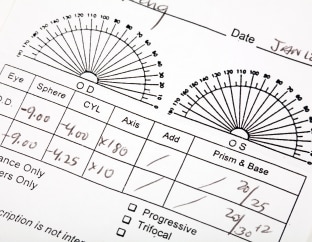It's important to understand how to read your eyeglass prescription accurately to ensure you get the right lenses for your visual needs. While you likely know whether you’re nearsighted, farsighted or have astigmatism, determining that from your prescription slip is another thing entirely.
That's why we have created a helpful guide to simplify the process and assist you in ordering your perfect pair of eyeglasses quickly and easily.
<<<<<< Image or Video >>>>>>
In case your eyesight has changed after an eye check-up, it's important to get a new prescription from your optometrist or ophthalmologist and order your new glasses accordingly.
Online retailers usually require you to enter your prescription details into their order form, which can be challenging if you are not familiar with how to read it.
What do all these numbers and letters mean?
 The precise description of how your glasses lenses should be cut is provided by the numbers on your eyeglass prescription. Keep your prescription up-to-date so that these numbers can accurately reflect your visual requirements. On your prescription, several abbreviations and words label all of the important data. To know the meaning of SPH, CYL Axis, Prism, PD, and more, refer to the information below.
The precise description of how your glasses lenses should be cut is provided by the numbers on your eyeglass prescription. Keep your prescription up-to-date so that these numbers can accurately reflect your visual requirements. On your prescription, several abbreviations and words label all of the important data. To know the meaning of SPH, CYL Axis, Prism, PD, and more, refer to the information below.
OD vs. OS Eye
OD: The Latin term Oculus Dexter, which means right eye, is abbreviated as OD.
OS: On eyeglass prescriptions, you'll often see the term OS, which is an abbreviation of the Latin term "oculus sinister," meaning left eye.
Sphere, Cylinder, and Axis on Eye Prescriptions
SPH: The sphere (SPH) value on your eyeglass prescription is the lens power needed for clear vision. If the number has a minus (-) symbol, it indicates nearsightedness, while a plus (+) symbol signifies farsightedness correction.
CYL: The cylinder (CYL) value in your prescription is used to correct astigmatism. If the CYL column is blank, it means you don't have astigmatism.
AXIS: If you have an astigmatism, your prescription will include an axis number indicating the angle of the lens that should not have a cylinder power to correct your astigmatism.
Nearsighted prescriptions:
To correct nearsightedness, your prescription will show a number with a minus (-) symbol in the 'sphere' box, which indicates the required lens shape to improve your distance vision.

Farsighted prescriptions:
If you have a farsighted prescription, you will see a number with a plus (+) symbol in the 'sphere' box. This indicates that your lenses should be shaped to improve near vision.

Astigmatism prescriptions:
In case of astigmatism, your prescription will have a number in the 'cylinder' column indicating the required lens power to correct it. Additionally, there will be a number in the 'axis' column that's crucial for astigmatism correction.


